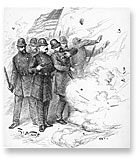What has come to be known as the Haymarket Affair began on May 3, 1886, when Chicago police fired into a crowd of striking workers at the McCormick Reaper Works, killing and wounding several men. The following evening, anarchist and socialist labor leaders organized a meeting of workingmen near Chicago's Haymarket Square. Speakers at the meeting denounced the police attack of the previous afternoon and urged workers to intensify their struggle for an eight-hour workday and other improvements in labor conditions.
Just as the meeting was breaking up, the police, led by Captain William Ward and Inspector John Bonfield, arrived on the scene and attempted to disperse the crowd. During this effort, someone threw a dynamite bomb into the ranks of the police, killing one officer outright and injuring others. A melee ensued, the police, and probably others in the crowd, fired shots. Seven police officers were killed or mortally wounded, and one died of his wounds several years later. How many casualties the workers sustained that evening is not known, as those who fell were quickly dragged to safety or to medical attention by their comrades.
|

| ||
|
The unknown bomber's act resounded nationwide. Public opinion was instantly galvanized against the radical left, resulting in the first "Red Scare" in America. In a climate of political paranoia fueled by the popular press, the police arrested eight prominent Chicago anarchists and charged them with conspiracy to murder. The eight were tried before Judge Joseph E. Gary in the Circuit Court of Cook County. Although no evidence emerged to tie any of the men to the bombing, the jury returned a verdict of guilty after deliberating for less than three hours. The court sentenced Oscar Neebe to fifteen years in the penitentiary and the others to death by hanging.
The attorneys for the defense immediately appealed the verdict to the Illinois Supreme Court which upheld the verdict against the anarchists on September 14, 1887. The defense then petitioned the U.S. Supreme Court for a writ of error. After three days of testimony by counsel for the convicted, however, the Supreme Court dismissed the petition on November 2, 1887, leaving amnesty as the only remaining option for the defendants.
On November 11, 1887, Albert Parsons, August Spies, George Engel, and Adolph Fischer were hanged. Louis Lingg escaped the hangman's noose by committing suicide in his cell the day before he was scheduled to climb the scaffold. Illinois governor Richard Oglesby commuted the sentences of Samuel Fielden and Michael Schwab to life in prison. In 1893, Oglesby's successor, John Peter Altgeld, pardoned the three surviving defendants, Fielden, Schwab, and Neebe, at the cost of his own political career.
The Haymarket Affair was a momentous and controversial event in Chicago's history and in the history of the American labor movement. In Chicago, a monument was erected in Haymarket Square to memorialize the police officers who lost their lives. Throughout the United States and Europe the executed anarchists became known as "the martyrs of Chicago."
Selected Print Sources on the Haymarket Affair Paul Avrich. The Haymarket Tragedy. Princeton, N.J.: Princeton University Press, 1984. (The most comprehensive survey of all of the events surrounding the Haymarket Affair.) Carl S. Smith. Urban disorder and the shape of belief: the Great Chicago Fire, the Haymarket bomb, and the model town of Pullman. Chicago: University of Chicago Press, 1995. Robert W. Glenn. The Haymarket Affair: an annotated bibliography. Westport, Conn.: Greenwood Press, 1993. Dave Roediger & Franklin Rosemont. Haymarket scrapbook. Chicago: C.H. Kerr Publishing Co., 1986. William J. Adelman. Haymarket revisited: a tour guide of labor history sites and ethnic neighborhoods connected with the Haymarket Affair. Chicago: Illinois Labor History Society, 1976). John S. Kebabian, ed. The Haymarket Affair and the trial of the Chicago anarchists, 1886. Original manuscripts, letters, articles, and printed material of the anarchists and of the State prosecutor, Julius S. Grinnell. Described and with an introduction by John S. Kebabian. New York: H. P. Kraus, 1970. Philip S. Foner. The autobiographies of the Haymarket martyrs, edited and with an introduction by Philip S. Foner. New York: Published for American Institute for Marxist Studies by Humanities Press, 1969 The Accused and the accusers; the famous speeches of the eight Chicago anarchists in court. With an introduction by Leon Stein and Philip Taft. New York: Arno Press, 1969. Henry David. History of the Haymarket affair; a study of the American social-revolutionary and labor movements. New York: Farrar & Rinehart, Inc., 1936.
For an in-depth analysis of the history of the Haymarket Affair, please visit The Dramas of Haymarket, an affiliated, interpretive web site developed by Northwestern University in cooperation with the Chicago Historical Society.
| |||
| |||
